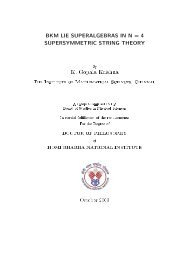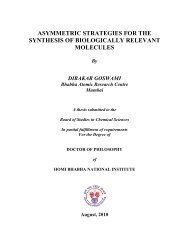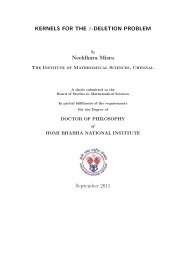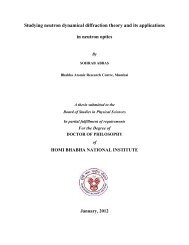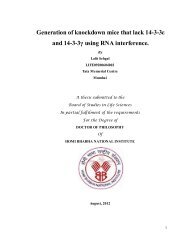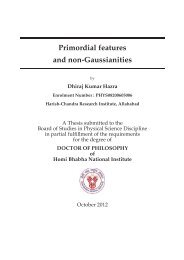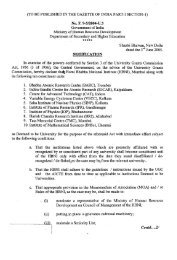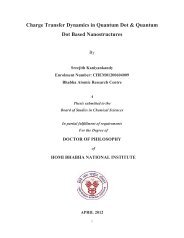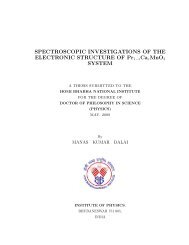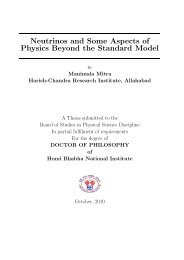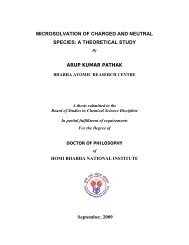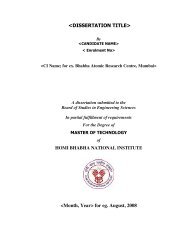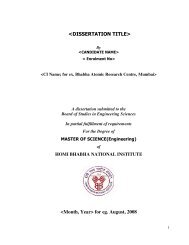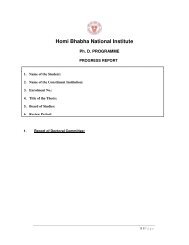- Page 1 and 2:
" "! %&''( )*
- Page 4 and 5:
! " # $ % &
- Page 6 and 7:
$* +%#, The author wish to express
- Page 8 and 9:
2.3 Effect of alloying elements on
- Page 10 and 11:
4 C H A P T E R 4 73 # $%&' 4.1 In
- Page 12 and 13:
6.2.3.2 Open circuit potential vs.
- Page 14 and 15:
eprocessing can be recovered, and c
- Page 16 and 17:
The ex-situ study of passive film w
- Page 18 and 19:
Fig.3.10: Schematic of electrical e
- Page 20 and 21:
Fig.6.11: Polarization study of unc
- Page 22 and 23:
AISI: American Institute of Steel I
- Page 24 and 25:
Chapter 1 C H A P T E R 1 Spent Nuc
- Page 26 and 27:
Chapter 1 1.3 Challenges in spent n
- Page 28 and 29:
Chapter 1 corrosion resistance. The
- Page 30 and 31:
Chapter 1 choice of zirconium is du
- Page 32 and 33:
C H A P T E R2
- Page 34 and 35:
Chapter 2 temperature, (c) higher i
- Page 36 and 37:
Chapter 2 Chromium in excess of 12
- Page 38 and 39:
Chapter 2 2. 3 Effect of alloying e
- Page 40 and 41:
Chapter 2 The twins are identified
- Page 42 and 43:
Chapter 2 and at temperature around
- Page 44 and 45:
Chapter 2 of adsorption of oxygen o
- Page 46 and 47:
Chapter 2 transpassive dissolution
- Page 48 and 49:
Chapter 2 healing chromium oxide fi
- Page 50 and 51:
Chapter 2 their segregation to the
- Page 52 and 53:
Chapter 2 is intimately related to
- Page 54 and 55:
Chapter 2 in nature because the dis
- Page 56 and 57:
C H A P T E R3
- Page 58 and 59:
Chapter 3 3.1.1.2 Specimen preparat
- Page 60 and 61:
Chapter 3 ionized. However, differe
- Page 62 and 63:
Chapter 3 various industrial applic
- Page 64 and 65:
Chapter 3 In the present investigat
- Page 66 and 67:
Chapter 3 3.1.3.2 Atomic force micr
- Page 68 and 69:
Chapter 3 present on the surface fo
- Page 70 and 71:
Chapter 3 necessary condition is th
- Page 72 and 73:
Chapter 3 Y m is the sputter yield.
- Page 74 and 75:
Chapter 3 Fig. 3.7: Schematic of X-
- Page 76 and 77:
Chapter 3 rate of 10Å/min using 5
- Page 78 and 79:
Chapter 3 different doses of nitrog
- Page 80 and 81:
Chapter 3 The modulus of electroche
- Page 82 and 83:
Chapter 3 equivalent circuit as sho
- Page 84 and 85:
Chapter 3 reference electrode with
- Page 86 and 87:
Chapter 3 for understanding the pas
- Page 88 and 89:
C H A P T E R4
- Page 90 and 91:
Chapter 4 encountered by all materi
- Page 92 and 93:
Chapter 4 pitting, and intergranula
- Page 94 and 95:
Chapter 4 The ridged structure, and
- Page 96 and 97:
Chapter 4 nitric acid is that the b
- Page 98 and 99:
Chapter 4 Potential (V) Vs Ag/AgCl
- Page 100 and 101:
Chapter 4 4.2.3 In-situ electrochem
- Page 102 and 103:
Chapter 4 The surface morphologies
- Page 104 and 105:
Chapter 4 a b c d Opening up of gra
- Page 106 and 107:
Chapter 4 Intensity (Arbitrary unit
- Page 108 and 109:
Chapter 4 The chromium, and oxygen
- Page 110 and 111:
Chapter 4 Intensity (Arbitrary unit
- Page 112 and 113:
C H A P T E R5
- Page 114 and 115: Chapter 5 elements, and often impar
- Page 116 and 117: Chapter 5 5.2 Results and discussi
- Page 118 and 119: Chapter 5 Presence of oxygen is due
- Page 120 and 121: Chapter 5 was an increase in marten
- Page 122 and 123: Chapter 5 formation of Cr 2 N was a
- Page 124 and 125: Chapter 5 electrochemical environme
- Page 126 and 127: Chapter 5 N + Dose E corr (mV vs. A
- Page 128 and 129: Chapter 5 layer capacitance (C dl )
- Page 130 and 131: Chapter 5 correlation between surfa
- Page 132 and 133: Chapter 5 boundary dissolution was
- Page 134 and 135: Chapter 6 C H A P T E R 6
- Page 136 and 137: Chapter 6 193]. As a single phase c
- Page 138 and 139: Chapter 6 particles range from 8×1
- Page 140 and 141: Chapter 6 Results revealed that in
- Page 142 and 143: Chapter 6 The change over from capa
- Page 144 and 145: Chapter 6 The impedance parameters
- Page 146 and 147: Chapter 6 Conc. Substrate condition
- Page 148 and 149: Chapter 6 6.6a-d. The uncoated spec
- Page 150 and 151: Chapter 6 (55.18°) respectively, w
- Page 152 and 153: Chapter 6 OCP shifted in noble dire
- Page 154 and 155: Chapter 6 The high phase angle over
- Page 156 and 157: Chapter 6 Fig. 6.10d: Log f vs. Log
- Page 158 and 159: Chapter 6 Fig. 6.11b: Polarization
- Page 160 and 161: Chapter 6 Covalent aspect of lattic
- Page 162 and 163: Chapter 6 As compared to uncoated s
- Page 166 and 167: Chapter 6 Similarly, the plots for
- Page 168 and 169: Chapter 6 for the duplex coating, a
- Page 170 and 171: Chapter 6 Fig.6.16b: Polarization s
- Page 172 and 173: Chapter 6 6.2.3.5 Morphological exa
- Page 174 and 175: Chapter 7 C H A P T E R 7 The cha
- Page 176 and 177: Chapter 7 1. Surface morphology exa
- Page 178 and 179: Chapter 7 6 Duplex Ti-TiO 2 coated
- Page 180 and 181: Chapter 7 EC-SPM study on effect
- Page 183 and 184: [1] Baldev Raj, U. Kamachi Mudali,
- Page 185 and 186: [37] G. Okamoto, T. Shibata, Corros
- Page 187 and 188: [79] M. Moens, M. Van Craen, F.C. A
- Page 189 and 190: [117] R.E.Williford, C.F.Windisch J
- Page 191 and 192: [157] N. Mottu, M. Vayer, R. Erre,
- Page 193: [197] M. Metikos Hukovic, M. Ceraj
- Page 196 and 197: [19] H. H. Uhlig, Corros Sci, 19 (1
- Page 198 and 199: [57] J. F. Ziegler, J. P. Biersack,
- Page 200 and 201: [97] I. Betova, M. Bojinov, V. Kara
- Page 202 and 203: [139] V. Ashworth, R. P. M. Procter
- Page 204 and 205: [176] G. Frankel, G. Grundmeier, H.
- Page 207 and 208: List of publications 1. Referred



